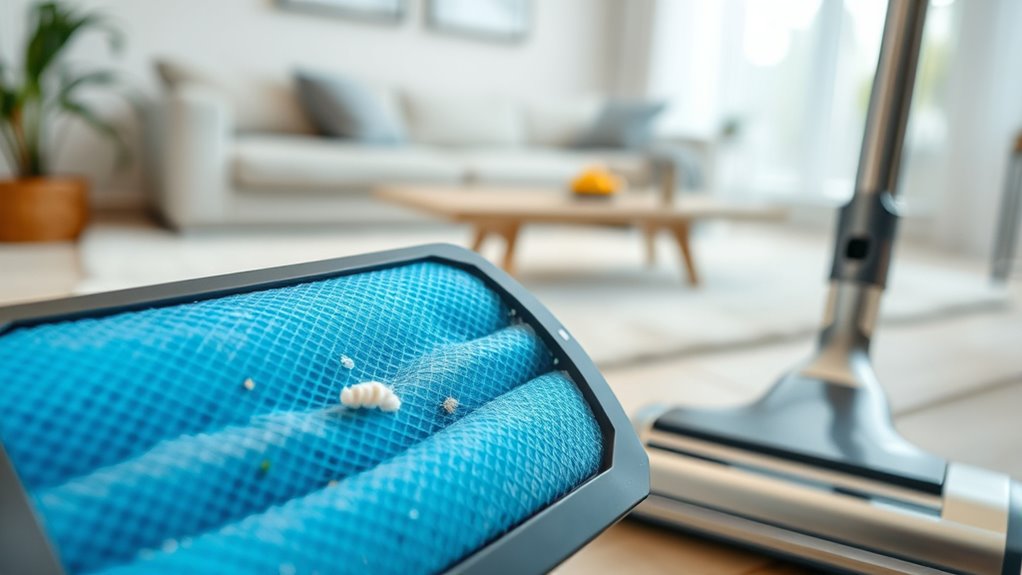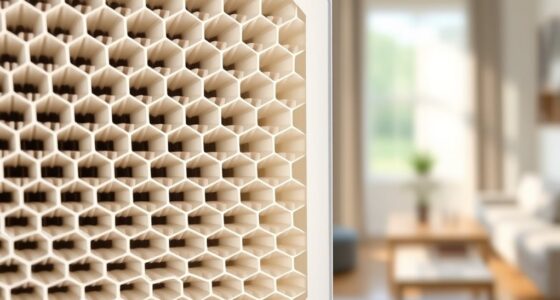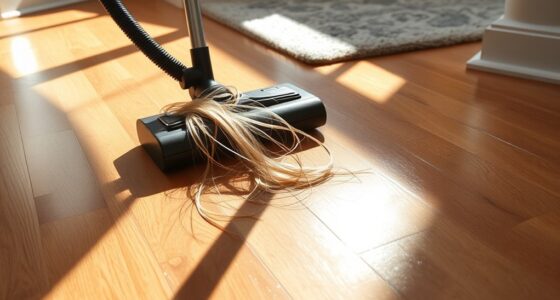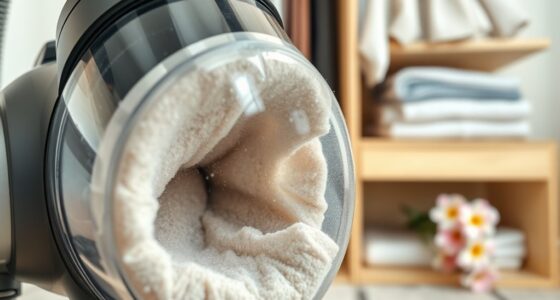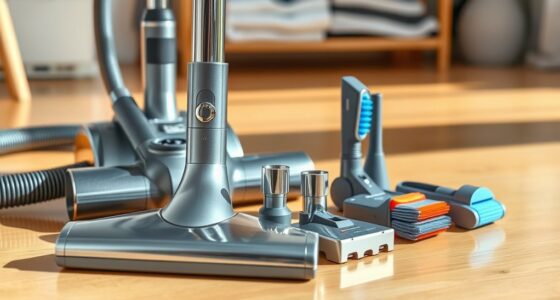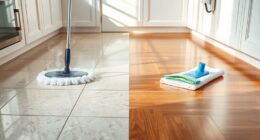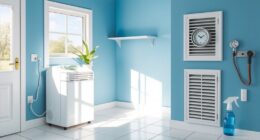Vacuum cleaner filters are essential for allergy prevention, as they trap harmful particles like dust and pet dander. To maintain their effectiveness, check and clean your filters every three months and replace HEPA filters every 6 to 12 months. Keep an eye out for decreased suction power or visible dust on filters, which indicate it’s time for maintenance. Choosing the right vacuum can further aid your efforts in reducing allergens. There’s more to discover about optimizing your vacuum’s performance.
Key Takeaways
- Regularly check and clean vacuum filters every three months to maintain optimal allergy prevention efficiency.
- Replace HEPA filters every 6 to 12 months to ensure effective allergen capture and indoor air quality.
- Use bagged vacuums for better allergen containment and replace bags when they are two-thirds full, usually every 4 to 6 weeks.
- Inspect for decreased suction power or visible dust on filters, indicating a need for cleaning or replacement to prevent allergen release.
- Choose vacuums with sealed designs and true HEPA filters for enhanced allergen control and improved indoor environment.
Understanding the Importance of Vacuum Cleaner Filters
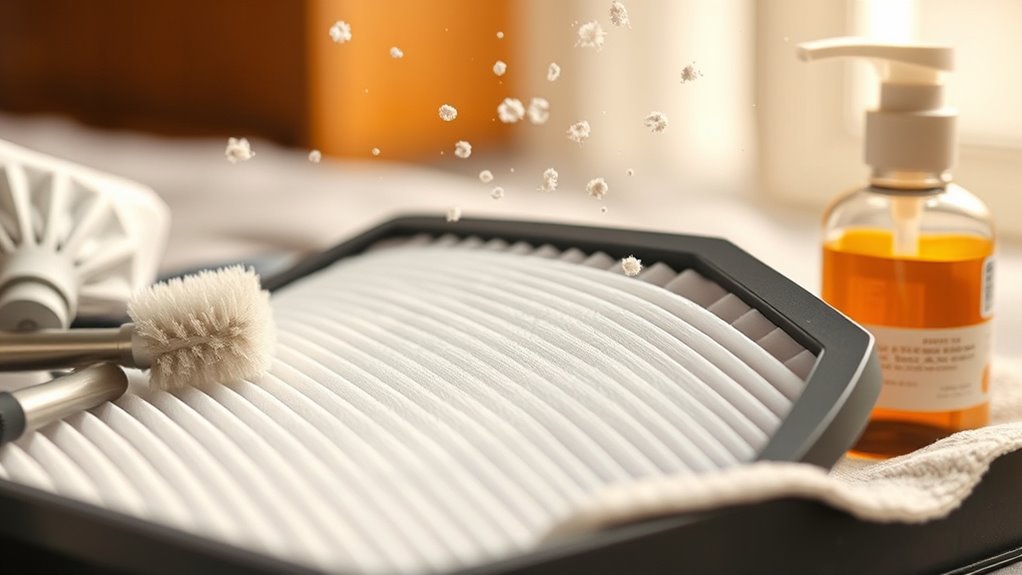
Vacuum cleaner filters play an essential role in maintaining a healthy indoor environment, especially for allergy sufferers.
HEPA filters are particularly effective, trapping 99.97% of particles as small as 0.3 microns, ensuring allergen removal for dust mites, pet dander, and mold spores.
HEPA filters trap 99.97% of particles as small as 0.3 microns, effectively removing allergens like dust mites and pet dander.
To enhance allergy prevention, you must prioritize regular maintenance of your vacuum cleaner filters. Cleaning or replacing them every 3 to 6 months keeps your filtration system effective and prevents indoor allergens from being released back into the air.
If you’re using a bagged vacuum model, you’ll likely experience better allergen containment compared to bagless options.
How Filters Help in Allergen Trapping
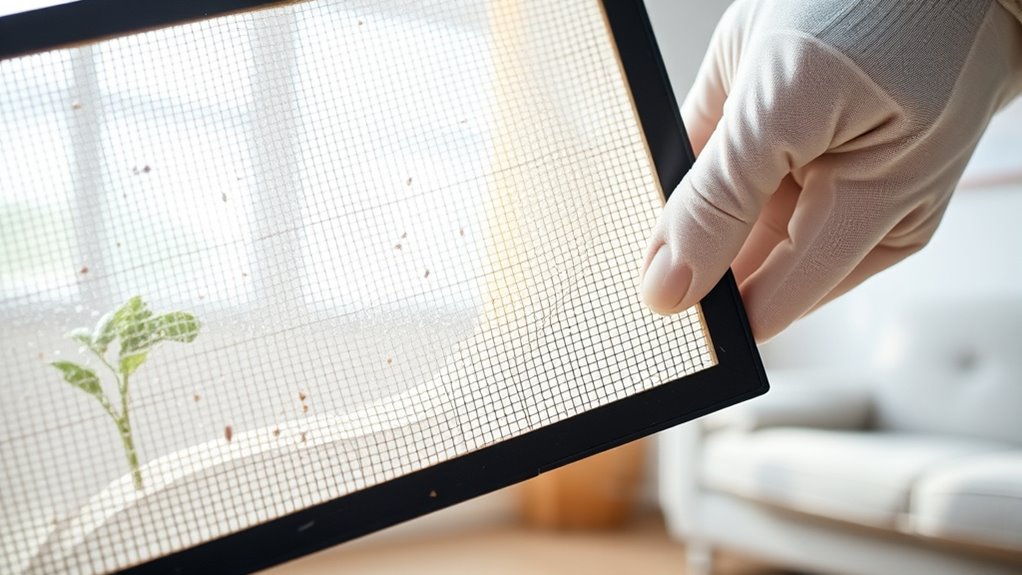
When it comes to trapping allergens, the efficiency of your vacuum’s HEPA filter is essential, as it captures 99.97% of particles down to 0.3 microns.
A sealed enclosure further guarantees that these particles stay contained during cleaning, preventing them from re-entering your air.
HEPA Filter Efficiency
There’s no denying that HEPA filters play an essential role in trapping allergens in your home. These filters effectively capture at least 99.97% of particles as small as 0.3 microns, including dust mites, pet dander, and mold spores. When you use a vacuum cleaner equipped with a HEPA filtration system, studies show significant reductions in allergy symptoms. However, to maintain this efficiency, proper maintenance is vital. Neglecting to clean or replace your HEPA filter can lead to reduced suction power, allowing allergens to escape back into the air.
| Filter Type | Particle Size Captured | Allergy Symptom Reduction |
|---|---|---|
| HEPA | 0.3 microns | Significant |
| Non-HEPA | >0.3 microns | Minimal |
| Clean Filter | Ideal performance | Maximum reduction |
| Dirty Filter | Ineffective trapping | Increased symptoms |
| Regularly Maintained | Enhanced efficiency | Improved air quality |
Sealed Enclosure Importance
To effectively combat allergens in your home, understanding the importance of a sealed enclosure in vacuum cleaners is vital. A sealed enclosure prevents allergens trapped by vacuum filters from escaping back into the air, greatly improving indoor air quality.
When using a vacuum with a true HEPA filter, you can capture 99.97% of particles as small as 0.3 microns, including dust mites and pet dander. High-quality vacuum cleaners feature well-sealed housings that guarantee effective allergen control during cleaning. Additionally, many top-rated vacuums include multi-surface capability, which allows for versatile cleaning across different areas of your home. Investing in a vacuum with advanced filtration systems will further enhance your ability to manage allergens effectively. Moreover, choosing models with high suction power can significantly improve the efficiency of dust removal from various surfaces.
This design maximizes the capture of airborne irritants, creating a healthier living environment for allergy sufferers. By investing in a vacuum with a sealed filtration system and HEPA filters, you’re taking an important step towards better allergen management in your home. Additionally, incorporating multi-functional devices that combine filtration with other features can further enhance your air quality efforts.
Regular Filter Maintenance
Although you mightn’t think about it often, regular filter maintenance is vital for keeping allergens at bay in your home.
HEPA filters can trap 99.97% of particles as small as 0.3 microns, effectively capturing allergens like dust mites and pet dander.
To guarantee peak performance, check and clean vacuum filters every three months. Neglecting filter maintenance can lead to reduced suction power and allergens being released back into the air.
If you use a bagless vacuum, this is even more important to avoid allergen clouding during emptying. Some models have washable filters, but they still need regular inspection.
Utilizing vacuum cleaners with sealed filtration systems enhances allergen trapping and helps maintain better indoor air quality.
Types of Filters for Allergy Prevention

When it comes to allergy prevention, choosing the right type of vacuum cleaner filter can make a significant difference in your home’s air quality. HEPA filters are necessary, trapping 99.97% of particles as small as 0.3 microns, including dust mites and pet dander. Bagged vacuum cleaners often outperform bagless models, as sealed bags contain allergens better and prevent exposure when disposed of. Additionally, activated carbon filters reduce odors and VOCs that can worsen allergies. Opt for vacuum cleaners with sealed enclosures to guarantee allergens don’t escape back into the air. Regular vacuum maintenance is vital for peak performance and allergy control.
| Filter Type | Benefits |
|---|---|
| HEPA Filters | Traps 99.97% of allergens |
| Bagged Vacuum Cleaners | Contain allergens effectively |
| Activated Carbon Filters | Reduces odors and VOCs |
| Sealed Vacuum Enclosures | Prevents allergen escape |
| Regular Maintenance | Guarantees efficiency and reduces allergens |
Signs That Your Vacuum Filter Needs Maintenance
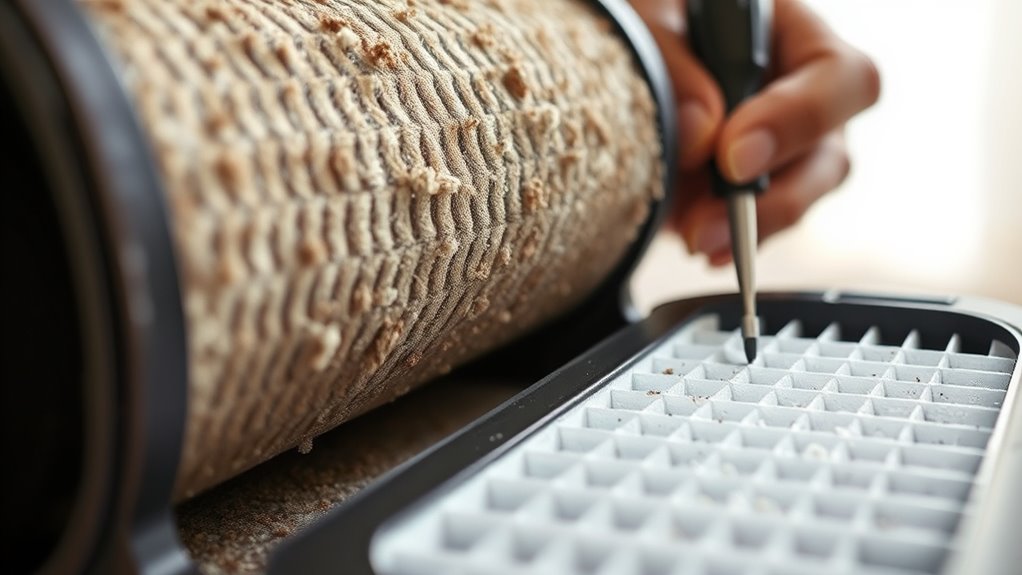
Regular maintenance of your vacuum filter is essential for peak performance and allergy control.
Here are some signs that indicate it’s time for cleaning or maintenance:
- Decreased suction power: If your vacuum’s sucking efficiency drops, the filter may be clogged.
- Visible dust or debris: A layer of dirt on the vacuum filter signals it needs cleaning or replacement to trap allergens effectively.
- Unusual odors: If you smell strange scents while vacuuming, your filter might be dirty and requires immediate attention.
Additionally, if you notice increased allergy symptoms after vacuuming, it could mean the filter isn’t functioning properly and is releasing allergens back into the air.
Regular checks, especially for HEPA filters, can help maintain effective allergy control.
Cleaning vs. Replacing Vacuum Filters
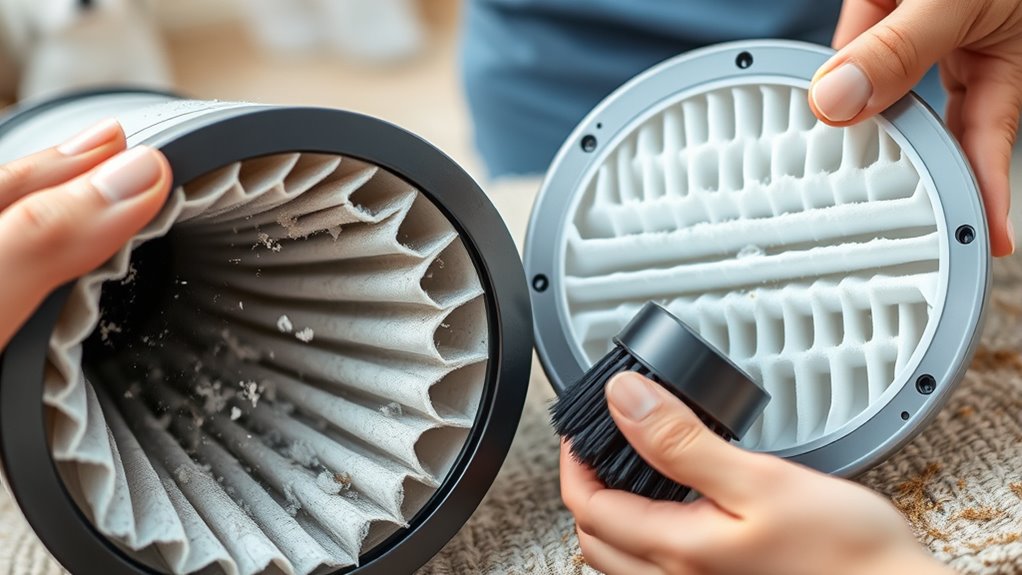
Cleaning or replacing your vacuum filter is crucial for maintaining its efficiency and effectiveness in allergy prevention.
HEPA filters trap 99.97% of particles as small as 0.3 microns, considerably reducing allergens in your home.
For bagged vacuum cleaners, you typically need to replace filters every 3-6 months, while bagless models may require cleaning or replacing every 6-12 months, depending on usage.
Neglecting this maintenance can lead to decreased suction power and increased allergen release, undermining your vacuum’s purpose.
Some models feature washable filters, allowing for cost-effective cleaning.
Always refer to the manufacturer’s guidelines to guarantee your vacuum filters remain effective in trapping allergens and maintaining peak performance.
Recommended Maintenance Schedule for Filters
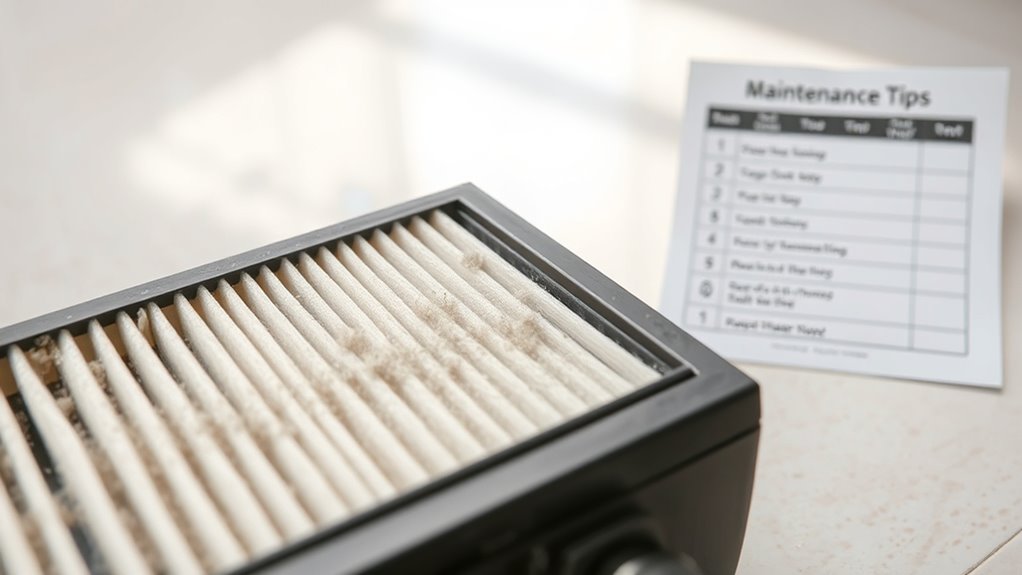
To keep your vacuum running efficiently and minimize allergens, you should follow a regular maintenance schedule for your filters.
Replace HEPA filters every 6 to 12 months and clean or replace pre-motor filters every 3 to 6 months.
Seasonal maintenance can also help you stay on top of filter care, ensuring your home’s air quality stays fresh. Additionally, regular cleaning of pre-filters and monitoring air quality indicators is essential to maintain optimal performance and prevent dust accumulation.
Regular Filter Replacement Timing
Maintaining your vacuum cleaner’s filters is essential for ideal performance and effective allergen control.
To achieve maximum allergen trapping, follow this maintenance schedule:
- Replace HEPA filters every 6 to 12 months.
- For bagged vacuum models, replace the bags when they’re about two-thirds full, usually every 4 to 6 weeks.
- Regularly check and clean pre-motor and post-motor filters every 1 to 3 months to avoid clogged filters that can reduce efficiency.
Cleaning Filter Recommendations
How often should you check your vacuum cleaner’s filters? For peak allergen trapping, inspect your HEPA filters every 6 to 12 months.
If you use a bagged model, change the vacuum bags and filters every 3 to 6 months, as they typically need less frequent maintenance.
For bagless vacuums, clean or replace the foam and HEPA filters at least every 3 months.
If you notice a decline in suction power, check your filters immediately, since clogged filters can severely impact your cleaner’s ability to trap allergens effectively.
Always refer to your user manual for specific maintenance guidelines to guarantee your vacuum operates efficiently and keeps allergens at bay.
Regular maintenance keeps your home healthier and your vacuum running smoothly. Additionally, consider the suction power of your vacuum when assessing its ability to manage allergens effectively.
Seasonal Maintenance Considerations
While you might think of vacuum maintenance as a once-a-year task, seasonal upkeep is essential for keeping allergens at bay.
To maintain ideal allergen trapping, follow this recommended schedule:
- Every 3-6 months: Replace or clean your vacuum cleaner filters, especially if you have pets.
- Monthly: Check and clean pre-filters to prevent clogging, guaranteeing effective allergen control.
- Bagged vacuums: Replace vacuum bags when they’re about two-thirds full to avoid releasing allergens during disposal.
For HEPA filters, adhere to the manufacturer’s guidelines for replacement.
The Impact of Dirty Filters on Indoor Air Quality

When filters in your vacuum cleaner become dirty, they can seriously compromise your indoor air quality. Clogged filters reduce the vacuum’s ability to capture allergens like dust, pollen, and pet dander, allowing them to be released back into your home.
A HEPA filter, when not properly maintained, loses its effectiveness and can no longer trap 99.97% of particles as small as 0.3 microns. This can greatly exacerbate allergy symptoms and increase airborne allergens by up to 50%.
To prevent these issues, follow maintenance tips such as checking and replacing your vacuum filters every three to six months. Keeping your filters clean guarantees peak suction power and helps maintain a healthier living environment.
Choosing the Right Vacuum for Allergy Management
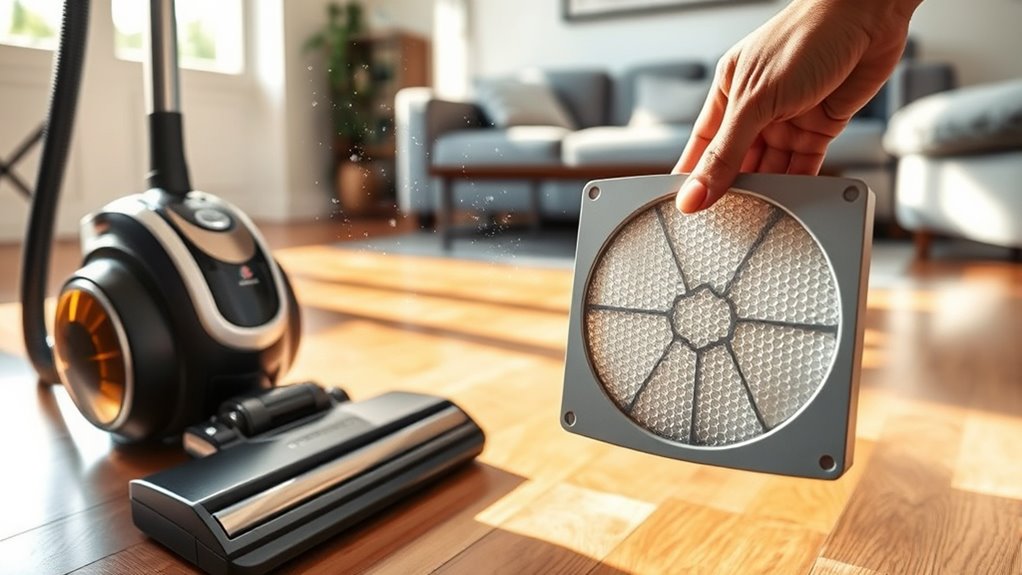
Choosing the right vacuum cleaner is essential for effectively managing allergies in your home. To guarantee ideal allergen removal, focus on these key features:
- HEPA filters: Choose vacuum cleaners equipped with HEPA filters that trap 99.97% of particles, including dust mites and pet dander.
- Bagged vacuum: Opt for bagged models, as they contain allergens better during disposal, reducing the risk of releasing them back into the air. Implementing a consistent cleaning routine can also promote stability in managing allergens effectively.
- Sealed enclosure: Confirm your vacuum has a sealed design to prevent allergens from escaping during cleaning. Additionally, a vacuum with energy-saving features can help you save on utility bills while maintaining a cleaner environment. Regular use of a vacuum can significantly improve indoor air quality, especially in homes with pets or frequent allergens.
These features enhance allergy management, making your cleaning routine more effective. Additionally, consider integrating your vacuum with smart home devices for improved monitoring of air quality during cleaning.
Don’t forget regular maintenance—replace HEPA filters and empty bags to keep your vacuum performing at its best in reducing allergens.
Additional Features to Look for in Allergy-Friendly Vacuums
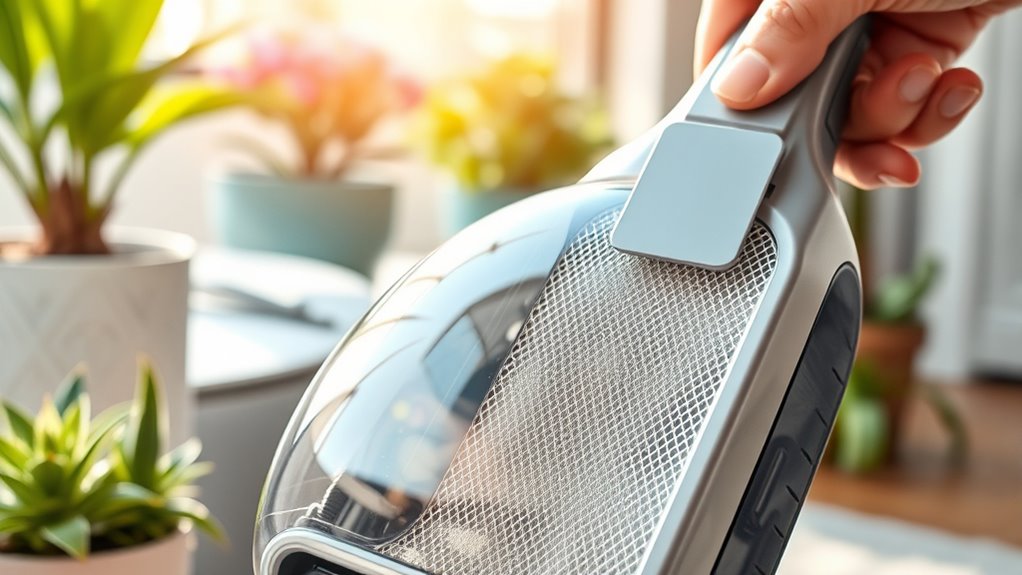
Finding the right vacuum cleaner for allergy management goes beyond just HEPA filters and bagged designs; there are several additional features that can greatly enhance your cleaning routine.
Look for vacuum cleaners equipped with HEPA filters, as they trap 99.97% of particles, effectively removing allergens like dust, pollen, and pet dander. A sealed enclosure design is essential, preventing allergens from escaping back into the air during operation. Additionally, models with high suction power are particularly effective at extracting deeply embedded allergens from various surfaces, thus improving overall air quality. Regular maintenance, such as hydration essential for vacuum filters, ensures they function optimally and last longer.
Choose models with strong suction power to tackle embedded allergens in carpets and upholstery. Specialized attachments, such as pet hair tools and crevice tools, can boost cleaning efficiency in hard-to-reach areas.
Finally, opt for a bagged vacuum to better contain allergens during disposal, reducing your risk of exposure when emptying dust bins. Regular filter cleaning is crucial for maintaining optimal airflow and enhancing the vacuum’s performance.
Best Practices for Vacuuming to Reduce Allergens
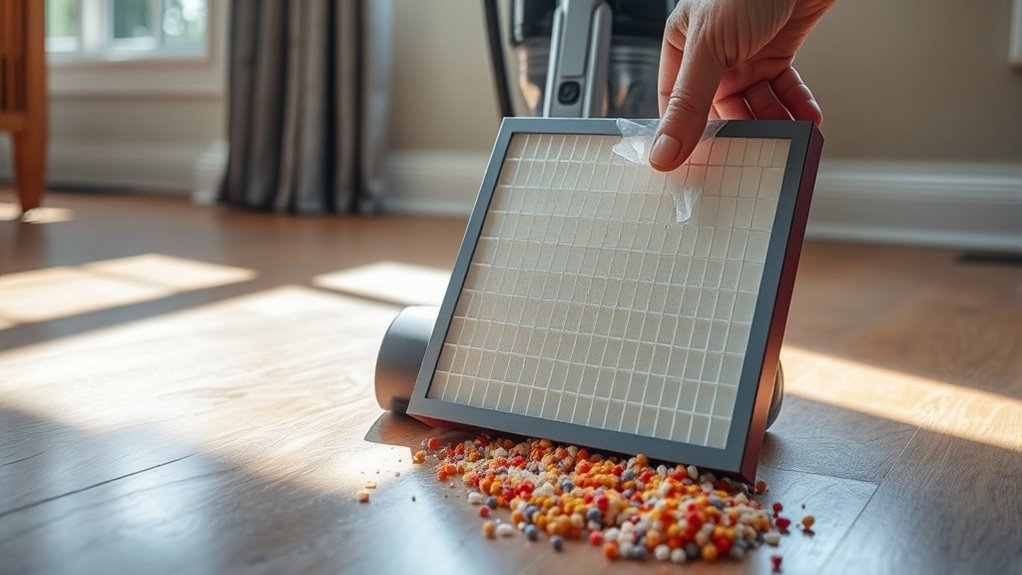
To effectively reduce allergens in your home, it’s essential to adopt best practices for vacuuming. Start by using a vacuum cleaner equipped with HEPA filters, which capture 99.97% of particles, including dust mites and pet dander. Regular vacuuming contributes to a healthier home by reducing allergens that can lead to respiratory issues.
To minimize allergens, use a HEPA-filter vacuum to capture 99.97% of dust mites and pet dander.
Establish a regular vacuuming schedule, focusing on high-traffic areas and upholstery to prevent allergen buildup. Here are some maintenance tips for effective cleaning:
- Move the vacuum slowly with overlapping strokes for thorough suction.
- Regularly empty dust bins or replace bags to maintain efficiency.
- Use specialized attachments for cleaning surfaces like upholstery and crevices. Additionally, pay attention to filtration systems as they play a crucial role in trapping allergens effectively. Incorporating regular fuel injection cleaning can also enhance air quality within your home by reducing harmful emissions from vehicles parked nearby. Using a vacuum with strong suction power can help ensure that even the smallest particles are effectively removed from your floors and carpets.
Frequently Asked Questions
Does Vacuuming Prevent Allergies?
Yes, vacuuming can prevent allergies.
When you regularly vacuum, especially with a vacuum that has a HEPA filter, you’re effectively removing airborne allergens like dust mites and pet dander.
Make sure you vacuum high-traffic areas and upholstery at least once a week.
Moving your vacuum slowly and using overlapping strokes boosts its effectiveness.
What Is the Purpose of the Filter in a Vacuum Cleaner?
Imagine the air swirling with dust and allergens while you vacuum.
The filter in your vacuum cleaner acts like a protective shield, capturing those tiny particles before they escape back into your home. It’s designed to trap dust, pollen, and pet dander, ensuring you breathe cleaner air.
Without a functioning filter, you’d simply be stirring up allergens, not removing them.
Do Air Filters Reduce Allergens?
Yes, air filters do reduce allergens.
When you use filters like HEPA, they can capture nearly 99.97% of airborne particles, including dust, pollen, and pet dander.
By regularly maintaining these filters, you guarantee they perform at their best, keeping your indoor air cleaner.
If you neglect to change them, you risk allowing allergens to circulate, which can worsen your allergy symptoms.
What Is the Proper Care and Maintenance of Vacuum Cleaner?
Think of your vacuum cleaner as a car; it needs regular check-ups to run smoothly.
You should replace or clean the HEPA filter every 6 to 12 months for peak performance. Change the bag when it’s about two-thirds full to maintain suction.
Check the pre-motor and post-motor filters every 3 to 6 months, and verify hoses are free of clogs.
Wipe down the exterior to keep it looking sharp and functioning well.
Conclusion
To sum up, keeping your vacuum cleaner filters in top shape can greatly reduce allergens in your home. Did you know that a study found proper filter maintenance can lower asthma attacks by up to 50%? By regularly cleaning or replacing your filters and choosing the right vacuum, you’re not just improving your indoor air quality—you’re also protecting your family’s health. Stay proactive in your vacuum maintenance, and breathe easier knowing you’re making a difference!
